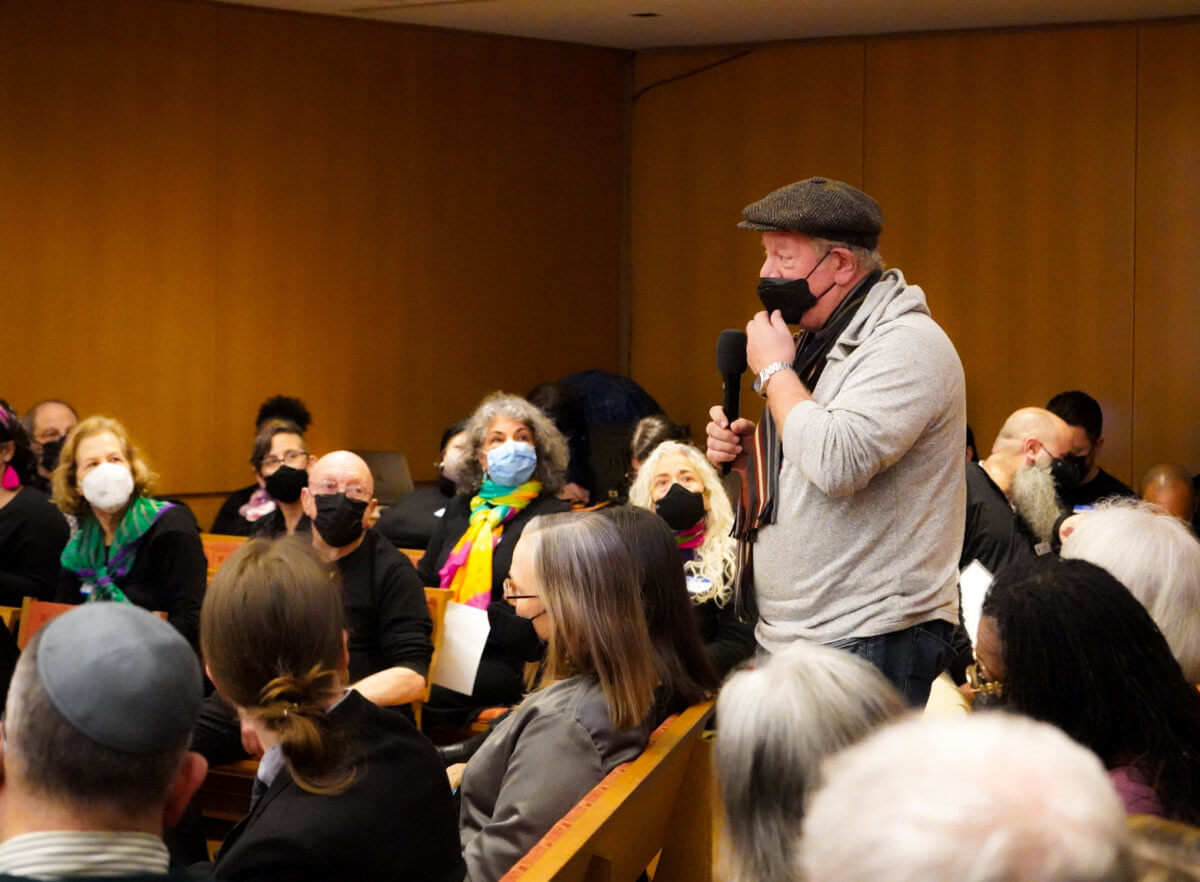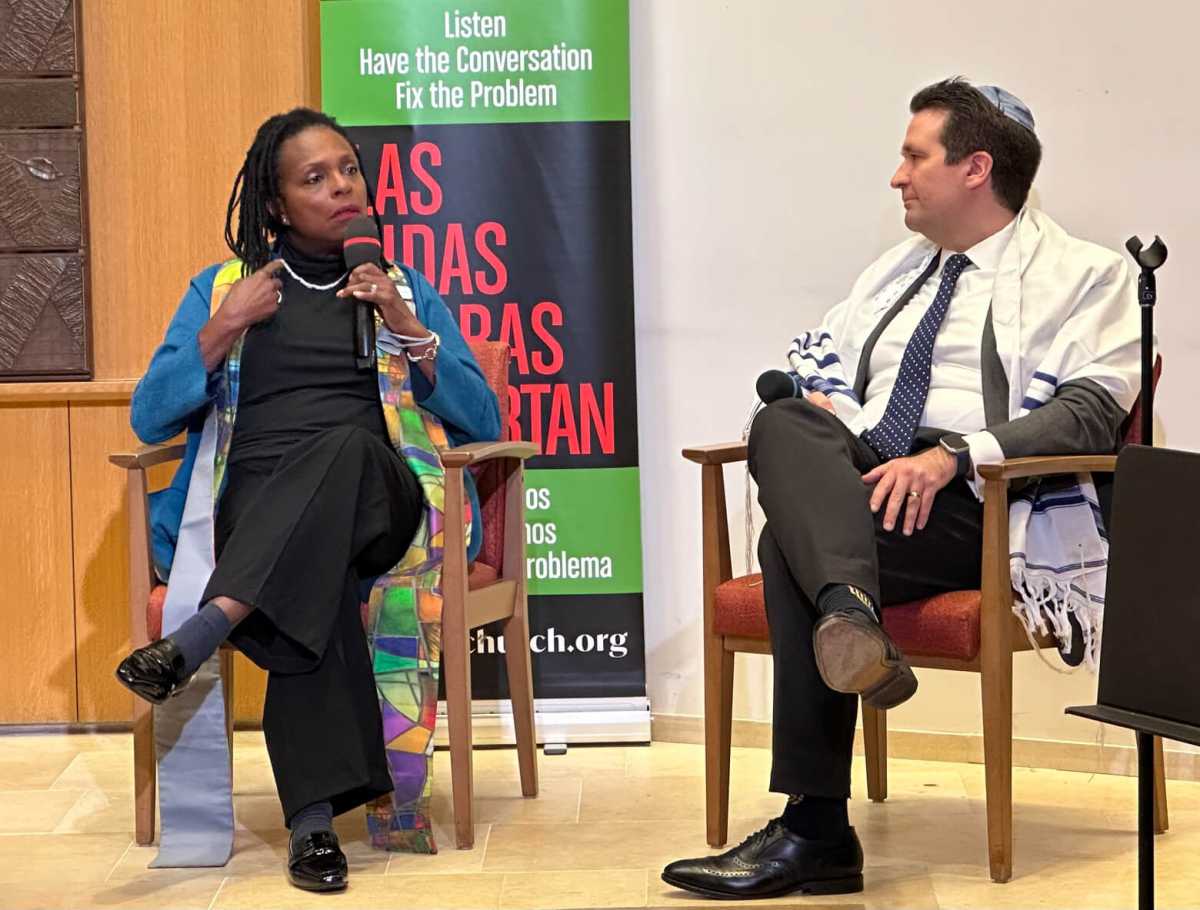Together this past Sunday, Jan. 15, Middle Collegiate Church and East End Temple held a Martin Luther King Jr. Teach-In, (Re) Building Black and Jewish Community. A particularly meaningful dialogue for these two congregations —a UCC and Reformed Church in America affiliate with a Reform Jewish congregation, they are intricately connected.
Two years ago, a six-alarm fire devastated the historic East Village Middle Church on 2nd Avenue. The East 17th Street Jewish temple offered its worship space to the congregants of Middle Church. Both congregations have roots in social justice; they found a good match.
Sunday worship launched the day. Middle Church (MC) is known for its foot-stomping Jerriese Johnson Gospel Choir, experienced for the first time by some attendees. From the temple’s ark, during the service, the rabbi brought out the torah—the scroll containing the first five books of the old testament; witnessing this religious object was a first for some of MC’s congregants.
The choir resounded through “Rich Man’s House” (Gonna take back what he stole from me) and belted out to hand-clapping accompaniment “Takin’ It to the Streets,” which got everyone’s blood pumping. Harmonious heart-felt vibes wrapped up the service with a rendition of “We Shall Overcome”, which did not feel cliche or dated.
(Re) Building Black and Jewish Community formally began as the two spiritual leaders—Reverend Jacqueline Lewis and Rabbi Joshua Stanton held a conversation addressed to all.
Among the topics touched upon: tensions between the Black and Jewish (and Christian) communities and the particular destructive nature of Kanye West and other celebrities’ anti-semitism; the United States never owning up to the trauma of slavery; and Black labor and reparations.
Rabbi Stanton revealed his attempts to confront his own personal prejudices and racism. He spoke at length about the lack of understanding experienced by Jews of Color within the Jewish Ashkanzi (ancestors from Eastern or Central Europe) community.
White supremacy and its many vile tentacles is a theme addressed many times during the dialogue. It included the stereotyping and racializing of Ashkenazi Jews.

Reverend Lewis reminded her co-religionist “siblings” that Jesus was Jewish, in fact Afro-Semitic. She challenged them to confront their own own prejudices—“to be anti-semitic is to be anti-Jesus; he was a Jew.”
She spoke of the pitting of minorities against each other, duking it out for the thin slice of the American dream.
“What are conversations going on in your community?” Rabbi Stanton asks Reverend Lewis? Her nuanced response is how, “We’re both walking wounded, Blacks and Jews from centuries of white supremacy.”
She continues, “I don’t understand those who say the Holocaust never happened. White people are wounded too; the sickness of white supremacy hurts every friggin’ body.”
Meanwhile Rabbi Stanton adds that the projected stereotypes of Jewish power (“the Jews are in control of…..”) sets up Jews as targets of violence and also positions them for failure.
Whiteness— the white supremacist whiteness ideology— is a construct against Blackness (also against Jewishness, LatinX, Hispanic, and Asian), elaborates Rev. Jacqui.
She adds an expanded definition, “White people are white, rich, Christian, straight, male– the superwhite that are the real white people. The rest are passing for white—not white enough. Everyone else is in a caste lower than that.” Challenging, she asks, ‘Do we want that, characterizations of white? White supremacy is the enemy of all of us.”
Middle Church member Joy Lau is struck by Rev. Jacqui’s observations that in an atmosphere of hate and hated, BOTH are so negatively affected.
Rev. Lewis commented that to counter people’s instinct reverting to one’s own tribe, one must increase your sense of tribe and consciously reach beyond your tribe.
Middle Church prides itself on attracting congregants that “look like the subway”— all religions and persuasions, gender and sexual identifications. Multi-cultural, multi-ethnic movements are what’s needed and Rabbi Stanton voiced that he experiences Middle Church as a master class in becoming a multi-cultural , multi-racial, multi-faith house of worship.






































